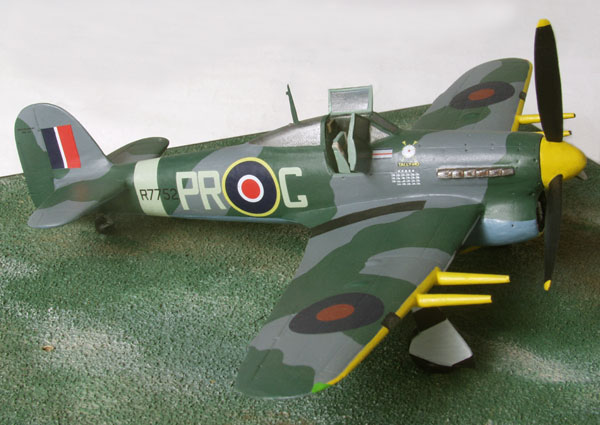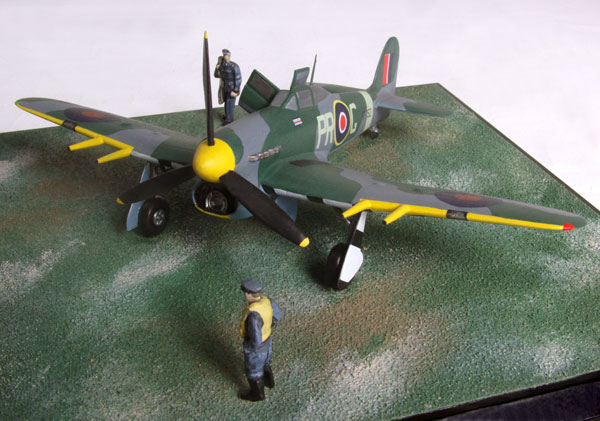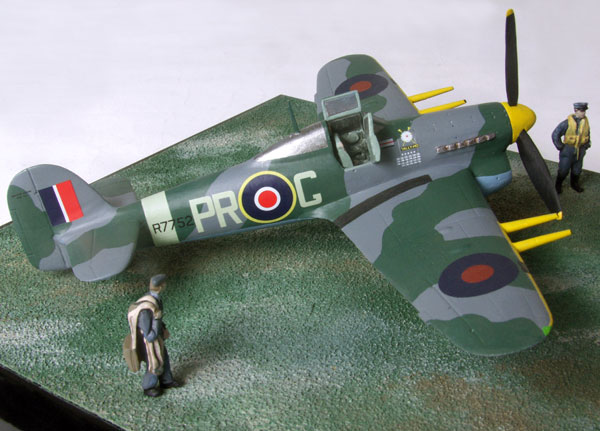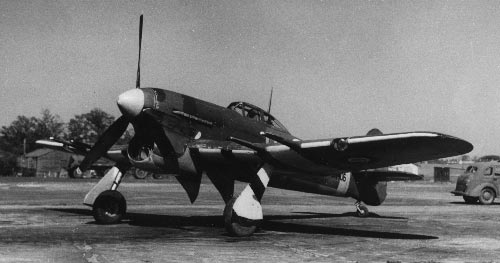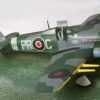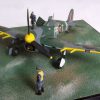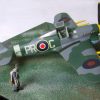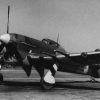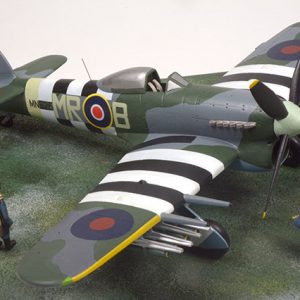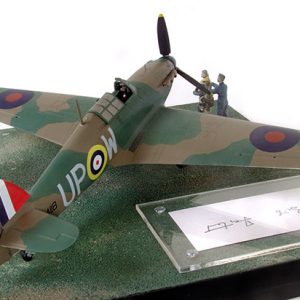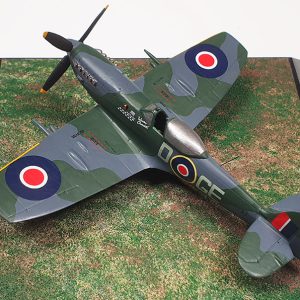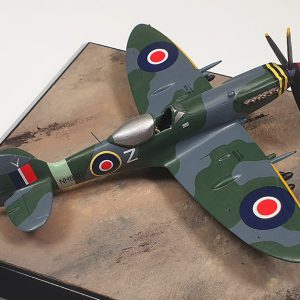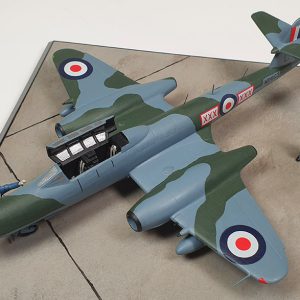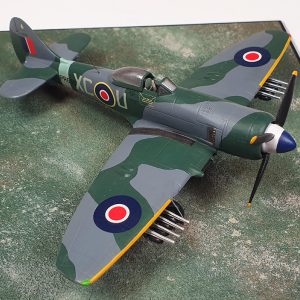Hawker Typhoon Mk IB R7752 PR-G 609 Squadron,
Sqn Ldr R P Beamont, RAF Manston, Spring 1943
Where Supermarine were able to develop the Spitfire progressively throughout the Second World War Hawker followed the Hurricane quickly with a wholly new aircraft. Their response to Specification F.18/37 – to which Fairey, Gloster and Supermarine also offered submissions – was to produce two designs with the same basic airframe but alternative engines; the ‘N type’ with the Napier Sabre became the Typhoon and the ‘R type’ with the Rolls-Royce Vulture the Tornado. The first prototype Tornado flew on 6 December 1939, and P5212, the first Typhoon, on 24 February 1940, the prototypes being built by Hawkers at Kingston and flown at Langley; but with the building of Hurricanes continuing until 1944 production of both the newer types was sub-contracted within the Hawker-Siddeley Group, Avro being responsible for the Tornado – though in the event they only produced one – and Gloster the Typhoon.
The Vulture engine was unsuccessful but the Sabre also had its development problems, and it took some while for the Typhoon to enter service. The first Gloster-built aircraft flew on 27 May 1941 and in September four were delivered to the RAF, two to the Air Fighting Development Unit and two to No.56 Squadron. The rate of climb, so important for an interceptor, was disappointing and engine failures were still frequent; and with over 150 Typhoons delivered before the end of 1941 there was a spate of accidents with failures of the rear fuselage which proved to be from a failure of the elevator mass balance weight mounting. While this was remedied reinforcing “fishplates” were added around the rear transport joint. The first Typhoon wing was established at Duxford in 1942, with 609 Squadron joining 56. R7752 was one of the first production batch built by Glosters at Brockworth at a rate of about one a day, and delivered between September 1941 and June 1942; this was a mixed batch of Mark IA (twelve .303 machine guns) and Mark IB (four 20 mm cannon) versions. R7752 was delivered to No.609 Squadron at Duxford on 2 June 1942 and allocated to the “boss”, Sqn.Ldr Paul Richey, who had taken over the day before; he had flown Hurricanes with No.1 Squadron during the Battle of France (his classic book “Fighter Pilot” recounted his experiences of the early war) and the individual identification letter ‘G’ was that of his earlier mount. The first time the Duxford Wing operated as a unit with the Typhoon was on Operation Jubilee, the Dieppe raid on 19 August 1942, and Richey flew ‘G’ on his first mission of that day. During and after this operation it became evident that both ground and air forces were mistaking the Typhoon Mk IB for Focke-Wulf Fw 190s, and various distinguishing markings were successively applied in the effort to avoid “friendly fire” incidents, the first being yellow chordwise bands on both upper and lower wing surfaces in line with the inboard cannon; 609 applied these at the end of September 1942.
In October Richey was posted to the Far East on promotion as Wing Commander Operations, Bengal, 609’s new CO being Sqn.Ldr. Roland Beamont. He took over R7752, which in addition to the new identification markings wore the Squadron Leader’s “pennant” and the unit badge, a white rose of Yorkshire with the motto “Tally Ho” that was a legacy of the squadron’s days as the West Riding of Yorkshire squadron. In November the special markings had been changed to include four 12″ black stripes under port and starboard wings and a white nose, this reaching to the back of the radiator cowl; by the end of the month white had been added between the black wing stripes but the white nose was abandoned quickly, as it compromised the camouflage in the increasing number of sorties across the Channel to Northern France.
In February R7752 emerged from Hawkers’ at Langley with yellow spinner, patch under the radiator and cannon fairings, and a “scoreboard” under its starboard white rose which had five iron crosses for Beamont’s victories in the Battles of France and Britain, and twenty locomotives; it was Beamont who led the use of the Typhoon Mk IB in the ground attack role which became its forte; this included operations at night, following similar sorties which Beamont had flown in the Hurricane with 87 Squadron. He was posted from 609 in May 1943, with the role with which the Typhoon MK IB was to become identified in operations with the Second Tactical Air Force firmly established proviving ground support armed with rockets on D-Day. In July 1943 R7752 was involved in an exchange of aircraft between 609 and 56, but the following month it was returned to Hawkers to be dismantled for spares. The “scoreboard” panel was presented to “Bea” at the end of his tour of operations, and is now in the hands of the 609 Squadron Association.


